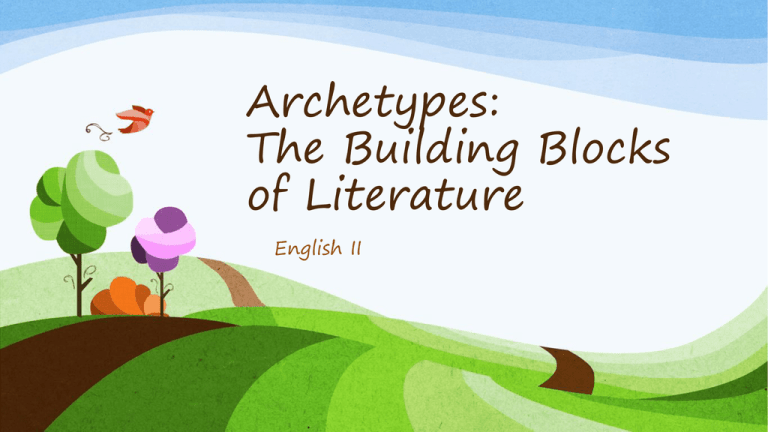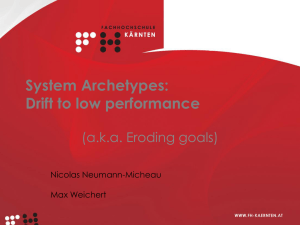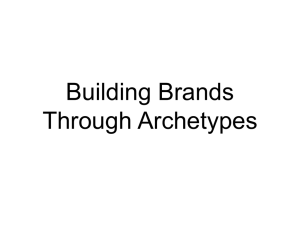Archetypes PowerPoint - Fort Thomas Independent Schools
advertisement

Archetypes: The Building Blocks of Literature English II Essential Questions: 1.What is an archetype, and why do writers use them in their works? 2.What are the various kinds of archetypes, and how do they contribute to the meaning of a text? 3.How do archetypes affect a text and the reader/observer? What Does Archetype Mean? Archetype is from the Greek word archetypon. arche “beginning; original” typon “model; pattern; mold” In literature, an archetype is a character, symbol, setting, plot element, or conflict that is repeated throughout various works from various cultures. From Where Does This Idea of Archetypes Come? Carl Jung • Observed that many cultures across the world and in many time periods have similar symbols, characters, conflicts, etc. in their literature and myths. • The collective unconscious: humanity keeps a memory of its shared experiences throughout time, which appears in archetypes. Archetypes: Essential Understandings 1. In literature, an archetype is a character, symbol, setting, situation, or conflict that is repeated throughout various works. 2. Archetypes are building blocks for stories. 3. Archetypes exist for many reasons: A.To explain natural phenomenon and religious experiences B. To answer questions about the meaning of life and what it means to be human C. To entertain D.To teach cultural roles, morality, and wise living Archetype Main Groups • Plot • Character • Symbolic • Setting Plot Archetypes The Journey • A hero must leave his kingdom to search for truth or acquire an object that will save the kingdom. • The journey includes the numerous characters encountered, experiences had, and life lessons learned. The Quest • What the hero must accomplish to restore order to his kingdom. • The quest often includes attaining an important object. The Task • The nearly superhuman feat the hero must perform to complete the quest. Battle Between Good and Evil • Despite all obstacles, good triumphs over evil. Death and Rebirth • Reflects the natural cycle of life and death. • Sometimes, characters experience a physical— literal—death, or they can experience a more symbolic decay. • Sometimes, characters experience a physical— literal—rebirth or resurrection, or they can experience a more symbolic return to life. The Unhealable Wound • Either a physical or psychological wound that cannot be fully healed. This wound often symbolizes a loss of innocence. Character Archetypes The Hero • The protagonist of the story • Circumstances of his birth are sometimes unusual; often raised by a guardian, not his biological parents • Leaves his kingdom to return only when he matures • Often characterized by courage, strength, and honor; the hero will sacrifice himself for the good of all • He leaves what is familiar for a new, challenging world Mentor (Wise Old Man) • Wise teacher of the hero • Often a father figure • Serves as a role model or the hero’s conscience • Sometimes gives the hero gifts: weapons, food, magic, Hunting Group of Companions • Loyal companions of the hero who are willing to face conflicts and stay together The Devil Figure • Person who represents evil incarnate • Sometimes offers worldly goods, fortune, or knowledge in exchange for control of the hero and/or other good The Outcast • A character banished from a social group for a real or imagined crime • Destined to wander from place to place Damsel in Distress • Vulnerable woman whom the hero must rescue • She is sometimes used as a trap to capture the hero Other Important Character Archetypes • Star-crossed lovers – two characters engaged in a love affair fated to end tragically for one or both due to the disapproval of society, friends, family, etc. • Father-son conflict – tension occurs between a son and his father, often due to psychological and/or emotional tension • Christ figure – a person sacrifices his own life for the good of others or sacrifices himself so that others do not die Symbolic Archetypes Light versus Darkness Light • suggests hope, renewal, or knowledge, or goodness Darkness • implies the unknown, ignorance, despair, or evil Heaven versus Hell Heaven • Realm of gods, forces of good, and life; often associated with the sky or mountain tops Hell • Realm of evil and/or death; often associated with the bowels of the earth Water • Life, growth, birth (or rebirth), spiritual birth, cleansing, purity Fire Positive • light, knowledge, life, purity, rebirth Negative • destruction, suffering, death Circle • the life cycle, completion, order, power, strength, unity, security Colors • Black – darkness, chaos, mystery, death, evil, wisdom • White – light, order, knowledge, life, goodness, purity • Red – blood, sacrifice, passion, disorder, evil, warning • Green – growth, hope, life, vegetation • Blue – peace, order, security Numbers • 1 – unity; wholeness; power • 3 – sacredness; Trinity (Father, Son, Holy Spirit); mind, body, spirit; birth, life, death • 4 – circle (life cycle); seasons; earth, nature, natural elements (earth, fire, air, water) • 6 – humanity; evil; devil • 7 – completion; perfection; order Setting Archetypes Underworld • place under the earth where the hero encounters fear and where his courage is tested; may contain a maze or labyrinth, which can symbolize the hero’s difficult decisions; often associated with death Forest • normal rules do not seem to apply; people and things run wild; associated with the unknown Tower • strong place often where evil resides; sometimes where a person is locked away, which represents isolation and the need for rescue River • the journey of life; change; metaphor for the passage of time; stages of human life; decision that cannot be taken back Mountain • obstacle; goal of a spiritual or emotional journey; mystery; power





